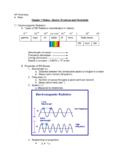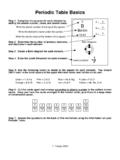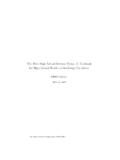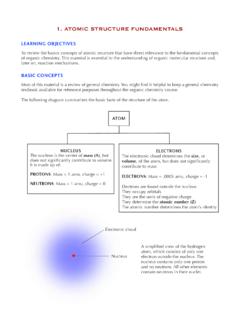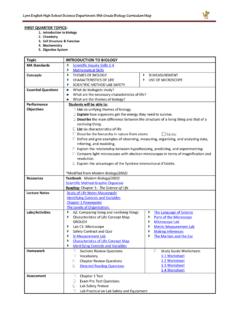Transcription of www.chemactive
1 GCSE CHEMISTRY atomic structure & BONDING. High Demand Questions QUESTIONSHEET 1. (a) Oxygen and sulphur are in the same group of the periodic table . Complete the table below to show the arrangement of electrons in oxygen and sulphur atoms. Atom shell 1 shell 2 shell 3. oxygen sulphur [2]. om (b) (i) Draw a diagram of an oxygen atom. [2]. ctiv (ii) Use your diagram to describe two ways in which oxygen can achieve a full outside shell of electrons.. ma .. [2]. he (c) Some of the oxygen in the atmosphere is in the form of ozone, O3. Scientists believe that chlorine radicals are destroying ozone.
2 (i) What is the difference between a chlorine radical and a chlorine molecule? .. [2]. ww (ii) What substances are thought to be main sources of chlorine radicals in the atmosphere? .. [1]. TOTAL / 9. GCSE CHEMISTRY atomic structure & BONDING. High Demand Questions QUESTIONSHEET 2. (a) There are eleven electrons in a sodium atom. The amounts of energy required to remove each one have been measured and the results shown on a sketch graph. 180000. 160000. 140000. 120000. Energy /kJmol-1 100000. 80000. om 60000. 40000. 20000. 0. 1 2 3 4 5 6 7 8 9 10 11.
3 Number of electrons ctiv (i) Why is the first electron in sodium the easiest to remove? .. [2]. ma (ii) Why do the energies for electrons 2 to 9 go up by relatively small amounts? .. [1]. he (iii) Why are the last two energies very high? .. [1]. (b) Draw a sketch graph to show the energies needed to remove the first four electrons in aluminium. Explain your answer. ww .. [3]. TOTAL / 7. GCSE CHEMISTRY atomic structure & BONDING. High Demand Questions QUESTIONSHEET 3. 40. (a) (i) Explain what is meant by the numbers in the symbol 20 Ca .. [2]. 40. (ii) Use the numbers to state the number of protons, neutrons and electrons found in 20 Ca protons neutrons electrons om [3].
4 (b) Complete the table below to show the numbers of protons, neutrons and electrons found in the ions shown. ion protons neutrons electrons 1. H+. ctiv 1. 9. 4 Be 2 +. 56. Fe 3+. ma 26. 127. 53 I . he 79. 34 Se 2 . [8]. ww TOTAL / 13. GCSE CHEMISTRY atomic structure & BONDING. High Demand Questions QUESTIONSHEET 4. 20 22. Neon has two main isotopes, 10 Ne and 10 Ne (a) Draw diagrams of the atoms of each of the neon isotopes. om [3]. (b) Neon gas is made up of 90% of neon-20 and 10% of neon-22. Calculate the exact relative atomic mass of neon.. ctiv.
5 [3]. ma (c) How do the chemical properties of each isotope of neon compare with each other? Explain your answer.. he .. [3]. ww TOTAL / 9. GCSE CHEMISTRY atomic structure & BONDING. High Demand Questions QUESTIONSHEET 5. The diagram below shows the electronic arrangement of an unknown substance. om (a) (i) How many protons would there be if the unknown substance was a neutral atom? .. [1]. (ii) What would the diagram represent if it was a neutral atom? .. [1]. ctiv (b)(i) How many protons would there be if the substance was a 2+ ion? .. [1]. ma (ii) What would the diagram represent if it was a 2+ ion?
6 [1]. he (c) (i) In what group of the periodic table would the unknown substance be if the represented a 1+ ion? .. [1]. (ii) How many neutrons would the 1+ ion have if its relative atomic mass was 39? .. [1]. (d) (i) In what group of the periodic table would the unknown substance be if it represented a 1- ion? ww .. [1]. (ii) What would the relative atomic mass of the 1- ion be if it had 20 neutrons? .. [1]. TOTAL / 8. GCSE CHEMISTRY atomic structure & BONDING. High Demand Questions QUESTIONSHEET 6. An unknown element is found to exist as the following two isotopes: 24 28.
7 13 X 13 X. (a) Complete the following table : number of protons number of neutrons number of electrons 24. 13 X 13. om 28. 13 X 13 15. [2]. (b) Describe what is meant by the term isotopes'.. ctiv .. [2]. ma (c) In experiments, both isotopes were found to show the same chemical behaviour. Use the information in the table to explain why the chemical behaviour of both isotopes is the same.. he .. [2]. (d) A naturally occurring sample was found to contain 25% of X-24 and 75% of X-28. Calculate the relative atomic mass of the element X.. ww .. [3]. (e) Use your periodic table to identify X.
8 [1]. TOTAL / 9. High Demand Questions QUESTIONSHEET 7. GCSE CHEMISTRY atomic structure & BONDING. The diagrams below represent the electronic arrangement of different atoms and ions. A B C. om D E F. (a) Which letter represents an atom of a Group I metal? ctiv .. [1]. (b) Which letter represents an atom of a Group VII non-metal? .. [1]. ma (c) Which letter represents an atom of a noble or inert gas? .. [1]. he (d) Which letter represents an atom which is not in the second period of the periodic table ? .. [1]. (e) Which letter represents an ion of a Group I metal?
9 [1]. ww (f) Which two letters represent atoms which form an ionic compound with a formula similar to Na2S? .. [1]. (g) Which two letters represent atoms which form a molecule with a formula similar to SiCl4? .. [1]. TOTAL / 7. High Demand Questions QUESTIONSHEET 8. GCSE CHEMISTRY atomic structure & BONDING. (a) Use the periodic table to write down the electronic arrangement of: (i) calcium .. [1]. (ii) chlorine .. [1]. (b) If calcium is heated and put into a gas jar of chlorine a violent reaction takes place and solid calcium chloride is formed.
10 The reaction proceeds due to the transfer of electrons. om (i) Use the electron arrangements and the idea of electron transfer to explain how the reaction between atoms of calcium and chlorine takes place. (You may include a diagram in your answer). ctiv .. ma .. [4]. he (ii) Write down the formulae of the ions that calcium and chlorine form during the reaction.. [2]. (iii) Write down the formula of calcium chloride.. [1]. ww (c) Calcium chloride is a solid at room temperature and has a high melting point. Explain why calcium chloride has a high melting point.





